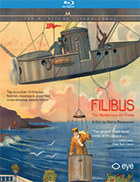Filibus: The Mysterious Air Pirate (Filibus, il misterioso pirata dell’aria)
|  Filibus: The Mysterious Air Pirate (Filibus, il misterioso pirata dell’aria), a lively and cleverly absurd silent-era feature about a rare female supercriminal, wasn’t based on a comic strip, but you could be forgiven for thinking that it was. With its array of early 20th-century futurist techno-gadgets, impossible derring-do, and criminal cat-and-mouse games, it feels like it was ripped straight from the same newspaper pages that featured Little Nemo in Slumberland or the pulp magazines that would spawn Tarzan, John Carter of Mars, and what we would now call steampunk. Alas, it was actually an original screenplay penned by Giovanni Bertinetti, a multitalented and widely published essayist, novelist, playwright, and screenwriter who also founded and directed Forum, an art and science magazine based in Turin. He also wrote some early science fiction, which clearly influenced his work on Filibus, which freely mixes fantastical and sci-fi elements into its criminal exploits. “Who is Filibus?” asked the film’s original advertising campaign, thus establishing its primary draw and mystery: the identity of the eponymous Filibus (Valeria Creti), a criminal mastermind who pulls off her daring heists with the aid of a futuristic mini-zeppelin that is always hovering in the air and can lower her via a gondola into any situation without being noticed. Filibus, whose backstory is never proffered and who appears to simply exist in her own right, has two alternate identities: the wealthy socialite Baroness Troixmond and the dandy gentleman Count de la Brive. She uses both identities to toy with the wealthy and the powerful by tricking and stealing from them. Her criminality is more prankish than nefarious, which separates her from the other European master criminals of the silent era, many of which clearly helped inspire her exploits, particularly Louis Feuillade’s serials Fantômas (1913) and Les vampires (1914), the latter of which featured the indomitable cat-suited burglar Irma Vep. Her main target is Detective Kutt-Hendy (Giovanni Spano), who is charged with investigating one of her crimes. In a particularly brazen move, she decides to frame him for her crimes with the use of false handprints, drugs, and a calculated redirection of a miniature camera. Filibus is so good at framing Kutt-Hendy that the poor man begins to doubt his own sanity, and all the while she is right under his nose, posing as Count de la Brive and courting the detective’s beloved sister, Leonora (Cristina Ruspoli). Produced in 1915 by Corona Films, a short-lived Turin-based company that produced just over two dozen films between 1914 and its bankruptcy in 1918, Filibus is a genuine curiosity of a silent-era thriller, borrowing liberally from its French predecessors while also pushing playfully at social roles and gender boundaries. At a time when Italian women were not allowed to divorce their husbands or even subscribe to a newspaper on their own, here was a film centered on a female super-criminal who dons both male and female disguises, regularly bests a renowned police detective by framing him for the very crimes he is investigating, and commands a small army of nameless male minions. She is always one step ahead, but even more importantly, goes about her business with an impudent sense of carefree abandon. Not only does she trump all the men around her, she has fun doing it and serves no other agenda beyond her own (she is no Batman or Robin Hood). In an essay on the film, Davide Mana calls Filibus “the first gender-fluid character in movie history” and “cinema’s first openly lesbian heroine,” which is arguably a case of overstatement given that Filibus’s sexuality is left decidedly vague. One could certainly interpret her as a lesbian, although that labeling is based primarily on her wooing Leonora when dressed as Count de la Brive, although said wooing is limited largely to a stately stroll in the garden that may or may not have been followed by other off-screen activities. Her gender fluidity is also entirely practical; that is, two of her three personas are men because they allow her access to society in ways that her female persona does not, which calls into question if we can see her gender fluidity as genuinely progressive or just prankish—much like Filibus herself. The play with gender roles and sex-switching identities was already old hat to screenwriter Giovanni Bertinetti, who wrote a series of popular “manuals of household wisdom,” including From the Kitchen to the Parlour (Dalla cucina al salotto, 1905) and Feminine Elegance (Eleganza femminile, 1907), under the female pseudonym “Donna Clara.” At other points in his career he wrote as an American scholar named Ellick Morn and produced 18 novels as a deceased author from Verona named Salgari. So, for Bertinetti, the idea of donning different identities—male or female—to achieve one’s goals was just a matter of course. Nevertheless, Filibus certainly stands out as a unique film of its era. It played as both a feature-length film and a five-part serial, but sometime after its run in the 1910s and early ’20s it became a lost film that only reappeared decades later when a copy was discovered in the Dutch Film Museum as part of the collection of cinema owner Jean Desmet, who had distributed it regularly for nearly a decade. After being restored, it screened at the 1989 Rotterdam Film Festival, where it scored high on the festival’s public opinion poll, according to an article in Variety, and later at the Festival del Cinema Ritrovato, organized by the Cineteca di Bologna in 1997, and at the 2013 Women’s Film Festival in Dortmund. The film remains a fascinating and entertaining thriller that throws caution and logic to the wind in its pursuit of fantastic criminality. Mario Roncoroni, an actor making his directorial debut, doesn’t do anything particularly showy or memorable (it is very much a film of static medium long shots), perhaps because he recognized that the sheer outlandishness of the film’s premise and narrative mechanics were more than enough to carry the day. He also knew to rely heavily on Valeria Creti, who plays Filibus and her many identities with a style and confidence that carries us right over the narrative gaps and leaps of logic and makes us want to fly alongside her to the next adventure, which, unfortunately never happened. While the end of Filibus is clearly intended to set up a continuing series of films, the bankruptcy of its production company following the outbreak of World War I just a few months after its premiere ensured that we would never know who exactly Filibus was and what other master plans she might pull off.
Copyright © 2021 James Kendrick Thoughts? E-mail James Kendrick All images copyright © Milestone Film & Video / Kino Lorber | |||||||||||||||||||||||||||||
Overall Rating: 

 (3)
(3)


